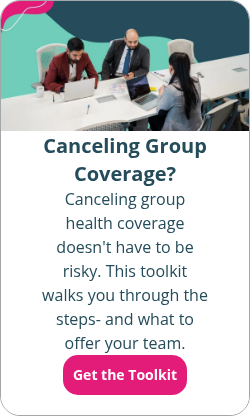What is group health insurance?
By Chase Charaba on February 19, 2025 at 9:15 AM
For decades, traditional group health insurance has been the go-to employee benefit. According to KFF1, 60.4% of people had employer-sponsored health insurance in 2023. That's about 164.7 million people who rely on employers to help cover their healthcare costs.
While most Americans are familiar with group health insurance, many don’t know how it works, why it has become so popular, or the challenges it presents. Understanding the ins and outs of group health insurance is particularly critical for employers looking to provide health benefits to their employees.
By the end of this article, you’ll have a clear understanding of whether group health insurance is the best fit for your organization—and what alternatives may work better.
In this blog post, you'll learn the following:
- Common types of plans employers can provide.
- The drawbacks of offering a group health plan to your employees.
- What affordable health insurance alternatives are available for organizations that want to save money.
What is a group health insurance plan?
A group health insurance plan is a form of health insurance provided to a group of people, usually employees of an organization. Individuals don't purchase their own group coverage since an individual isn't considered a group. Employers often buy group coverage from a health insurance company or health insurance broker. Then, they offer it as part of their employee benefits package.
In some cases, group health insurance members can access less costly monthly insurance premiums because the risk of insuring those members is spread across the entire group (for example, all of an organization’s workers).
There isn't just one type of group health insurance plan. Health insurance carriers offer various coverage options.
Some of the most common types of health insurance include:
- Health maintenance organization (HMO): An HMO is an insurance plan where policyholders must choose a primary care physician (PCP) for their healthcare needs. Policyholders and their dependents must get a referral from their PCP to see a specialist.
- Preferred provider organization (PPO): A PPO provides policyholders with a network of preferred healthcare providers and specialists (known as in-network care). PPO members can seek care outside their network, but often at a much higher out-of-pocket cost.
- Point of service (POS): This plan type is essentially a combination of an HMO and a PPO. POS members must choose a PCP but can also choose to get care outside of their network.
- Exclusive provider organization (EPO): Similar to a POS plan, an EPO combines aspects of an HMO and PPO. With an EPO, members must receive healthcare services from a pre-approved network of providers. EPO plans also offer the flexibility to see specialists without a referral.
Organizations can choose to offer an HMO, PPO, EPO, or POS plan as a high-deductible health plan (HDHP) to save money on monthly premiums. But, this type of plan comes with higher deductibles participants must reach before the plan coverage kicks in.
Employers can also offer self-funded group plans. With this type of plan, employers pay providers directly for covered medical items and services. While large organizations can save money by self-insuring, it can also create financial challenges. This is because the employer needs to have enough capital to handle employee insurance claims.
How group health insurance works
Employers purchase group health insurance policies and offer coverage to their employees and dependents. Once an employer selects a plan, employees can opt in or out of coverage. However, most plans require at least 70% of workers to participate.
KFF reports that2 the average yearly premiums for employer-sponsored health insurance in 2024 were $8,951 for individual coverage and $25,572 for family coverage. The employer and employees split the cost of insurance premiums.
Employers negotiate with insurers and brokers to select medical plans that best fit the needs of their workforce and their organization's budget. The cost of group health insurance varies, but it generally increases annually.
History of group health insurance
Group health insurance has a long history that dates back to the early 20th century. According to a report published by the Bureau of Labor Statistics3, the U.S. Marine Hospital Services was the first health plan in the U.S. in 1798.
Before the 1940s, most Americans paid for their own medical care. However, after the federal government implemented wage controls during World War II to avoid inflation, the War Labor Board exempted employer-paid health benefits. This tax advantage drove demand for group insurance.
While regulatory changes have impacted employer-sponsored health benefits, such as the introduction of the Employee Retirement Income Security Act (ERISA) in 1974 and the Affordable Care Act (ACA) in 2010, group health insurance has remained a valuable way for employers to provide health benefits to their workers.
Why do employers offer group health insurance?
Offering group health insurance is a way to attract and retain talented employees. Since most Americans are familiar with group plans, they see the value in having employer-sponsored insurance. A group plan can help improve employee satisfaction and engagement because it provides the healthcare services your workers need.
There are also tax benefits for employers and employees. Employer contributions toward premiums are tax-deductible, while employee contributions are often taken pre-tax. This reduces your employees' tax liability.
Depending on the size of your organization, you may also be legally required to offer health coverage to your workers.
Are organizations required to offer group health insurance?
While group health insurance is a popular benefit, not all organizations are obligated to offer it. However, under the Affordable Care Act's (ACA) employer mandate, all organizations with 50 or more full-time equivalent employees (FTEs) must provide qualifying health insurance to at least 95% of their full-time employees.
This coverage must:
- Include minimum essential coverage (MEC)
- Be affordable
- Provide minimum value (MV)
Applicable large employers (ALEs) that don't offer qualifying coverage to their workers and dependents will face employer-shared responsibility provision (ESRP) penalties.
How do employees enroll in group health insurance?
Employees generally have a limited amount of time to enroll in their employer's group plan as part of the plan’s annual Open Enrollment Period. Otherwise, they may need to wait until they qualify for a special enrollment period (SEP).
Individuals can only enroll in a group plan if their employer offers it or if they belong to certain membership organizations that offer insurance to their members (such as AARP). Otherwise, individuals will need to purchase an individual health insurance policy if they want coverage for the year.
Benefits of group health insurance plans
Group medical plans offer many benefits to employers and employees. Group plans provide comprehensive medical coverage to employees at a relatively low cost to members. Employers can help protect their employees from unexpected medical costs and life changes by offering a group plan.
Group health insurance often covers:
- Preventive care
- Hospitalizations
- Prescription drugs
Since most Americans have an employer-sponsored group plan, employees are also more familiar with them than other health benefits options. This means employers and human resources departments don't need to spend as much time educating employees about how to use their benefits.
Drawbacks of group health insurance
Group health insurance comes with its drawbacks.
Many businesses can’t afford it
One of the biggest problems of offering group coverage is the cost. Group health insurance premiums can be expensive, especially for small businesses and nonprofits.
When you run a small or medium-sized business, you tend to have a smaller workforce and a more limited budget. If you can't afford group coverage, you might consider not offering a health benefit. This can make hiring and retaining top talent more challenging. That's why more affordable alternatives exist for small businesses.
Even if you could afford to offer group coverage right now, annual rate renewals can be steep for business owners, leading to increased financial burden and stress.
Organizations don’t meet the minimum participation requirements
Minimum participation rates also pose challenges for small organizations. Insurance providers require a certain percentage of employees to enroll in the group health insurance plan for the organization to offer it. If the organization doesn't meet the minimum requirements, it leaves employees without access to care.
It doesn’t fit everyone’s needs
In the modern workplace, it's not unusual for employees to span five generations. With such a range of ages and unique healthcare needs, a one-size-fits-all approach doesn't work.
Group plans have limited flexibility for employees. They have little choice over their plan, so it may not cover their preferred doctors and specialists. This can create additional out-of-pocket costs for them.
Employers must carefully consider the costs associated with a group plan before making a decision. Thankfully, many alternatives to group health insurance are available for organizations of all sizes.
Challenges of finding coverage for employees in different states
Many organizations operate multi-state workforces. With the rise of remote work following the COVID-19 pandemic, many workers live outside of an organization's home state. While hiring these workers helps you find talented employees nationwide, it can pose problems when offering a group plan.
State-specific minimum participation requirements and other state regulations can make it difficult to find a policy that works for the entire workforce. This can mean managing multiple health plans at once.
Alternatives to group health insurance coverage
Traditional group medical insurance plans were the standard option for businesses of all sizes for decades. In recent years, however, many organizations have switched to more flexible alternatives. These alternatives may better suit the needs of your organization and your workers.
Self-insured plans
One alternative to a traditional group plan is a self-insured plan, also called a self-funded plan. With this type of health insurance, you assume all the financial risks of providing the benefit to your staff. You pay for each employee's out-of-pocket expenses instead of paying premium rates to a carrier.
Some benefits of offering a self-insured plan include being able to customize the plan to fit your particular needs, having complete control over the benefit, and being exempt from ERISA regulations.
But self-insured plans aren't feasible for most small businesses. Because organizations self-fund these plans, they must have enough capital to pay their employees' medical expenses. They also require much more administrative work than other options. However, employers can put some additional protections in place. They can get a stop-loss policy to get reimbursed for unexpectedly high claims.
Individual health insurance
Before we introduce the other alternatives, let's discuss individual health insurance coverage. These plans are available for individuals and families to purchase on the federal Health Insurance Marketplace, state exchanges, and private exchanges.
Marketplace plans offer comprehensive health coverage to individuals and families, including the ten essential health benefits under the ACA. While all marketplace plans have similar coverage, their premium costs differ based on the metal tier policy type—either bronze, silver, gold, or platinum insurance plans.
Individual health insurance plans are often cheaper than group coverage, and employees can purchase these policies themselves. While employers can't offer this type of coverage, they can reimburse employees for their monthly premiums through a health reimbursement arrangement (HRA).
Health reimbursement arrangements (HRAs)
An HRA is an employer-funded health benefit that allows you to reimburse your employees for their qualifying medical expenses. Depending on the type of HRA you offer, this can include individual health insurance premiums.
You simply set a monthly allowance for your employees and reimburse their medical expenses up to that amount. Your employees submit proof of their purchases to you for review. Once you approve the expense, you can reimburse employees up to their available allowance.
Some examples of HRA-eligible expenses include:
- Monthly premiums for individual health, vision, and dental insurance plans
- Preventive care
- Emergency care
- Mental health services
- Prescription drugs
- Over-the-counter medication
All reimbursements are tax-free for employers and employees. An HRA allows you to control your monthly benefit costs. Because you set the allowances, you can better budget for your annual expenses. Plus, you won't face any rate hikes from year to year unless you decide to increase your allowances.
You can administer three types of HRAs with PeopleKeep:
- The individual coverage HRA (ICHRA): An ICHRA is an excellent option for organizations that want flexibility in their health benefit. There are no maximum contribution limits, which means you can offer your employees as much as you like as an allowance. You can also define eligibility and allowances by employee class, such as part-time employees and full-time employees. However, your employees must have their own individual plans to participate in the ICHRA.
- The qualified small employer HRA (QSEHRA): A QSEHRA is a stand-alone HRA specifically designed for organizations with fewer than 50 full-time equivalent employees (FTEs). They come with maximum annual contribution limits set by the IRS. You must offer a QSEHRA to all full-time employees, but you have the option of determining whether or not to include part-time staff in this benefit. Unlike the ICHRA, your employees don't need their own individual health plan to participate in the QSEHRA. They only need a plan with MEC. Eligible employees can also have coverage through a spouse's or parent's group plan.
- The group coverage HRA (GCHRA): Also known as an integrated HRA, a GCHRA allows you to supplement your existing group coverage. You can reimburse your employees who participate in your group plan for out-of-pocket expenses like health plan deductibles, coinsurance, and other items. However, you can't reimburse employees for premiums.
Health stipends
The final alternative to group health insurance is a health stipend. A stipend is a sum of money you can offer to your employees to help them pay for various expenses. Health stipends are taxable, and you must report them as income on your employees' W-2s.
While stipends are more flexible than HRAs and group coverage, they aren't formal benefits. This means you can't require employees to use their stipends on healthcare items or ask for proof of purchase for a health insurance policy. They also don't satisfy the ACA's employer mandate for organizations with 50 or more FTEs.
How PeopleKeep by Remodel Health can help you offer alternatives to group medical insurance
HRAs are an affordable and flexible alternative to group health insurance. But administering one can be challenging for small organizations. That's where we can help! Our HRA administration software makes it easy to set up and manage your benefits in minutes each month.
We handle HRA compliance, plan documents, and review your employees' expenses so you can focus on running your business. Our award-winning customer service team is available to help you and your employees with any questions. Plus, your employees can shop for individual health insurance plans and ancillary benefits directly from their dashboards.
Conclusion
While most employers offer group health insurance, it can be extremely expensive and time-consuming to administer. The one-size-fits-all approach to group coverage can also leave your employees with fewer options for the healthcare services they need. That's why many organizations are switching to more personalized health benefits like HRAs to better attract and retain top talent.
Check out more resources
See these related articles

Group coverage vs. individual health insurance cost
In this article, we’ll compare group health and individual health insurance costs, and discuss a budget-friendly option for even more affordable insurance.

Small group vs. large group health insurance
Deciding between small group and large group health insurance? This comparison guide breaks down the differences to help you make an informed decision.

Pros and cons of group health insurance
In this post, we’ll discuss group health insurance, cover its pros and cons, and go over health benefit alternatives that can work for your organization.



